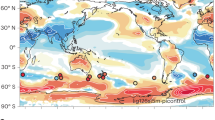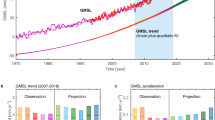Abstract
Sea-level change is an important consequence of anthropogenic climate change, as higher sea levels increase the frequency of sea-level extremes and the impact of coastal flooding and erosion on the coastal environment, infrastructure and coastal communities1,2. Although individual attribution studies have been done for ocean thermal expansion3,4 and glacier mass loss5, two of the largest contributors to twentieth-century sea-level rise, this has not been done for the other contributors or total global mean sea-level change (GMSLC). Here, we evaluate the influence of greenhouse gases (GHGs), anthropogenic aerosols, natural radiative forcings and internal climate variability on sea-level contributions of ocean thermal expansion, glaciers, ice-sheet surface mass balance and total GMSLC. For each contribution, dedicated models are forced with results from the Coupled Model Intercomparison Project Phase 5 (CMIP5) climate model archive6. The sum of all included contributions explains 74 ± 22% (±2σ) of the observed GMSLC over the period 1900–2005. The natural radiative forcing makes essentially zero contribution over the twentieth century (2 ± 15% over the period 1900–2005), but combined with the response to past climatic variations explains 67 ± 23% of the observed rise before 1950 and only 9 ± 18% after 1970 (38 ± 12% over the period 1900–2005). In contrast, the anthropogenic forcing (primarily a balance between a positive sea-level contribution from GHGs and a partially offsetting component from anthropogenic aerosols) explains only 15 ± 55% of the observations before 1950, but increases to become the dominant contribution to sea-level rise after 1970 (69 ± 31%), reaching 72 ± 39% in 2000 (37 ± 38% over the period 1900–2005).
This is a preview of subscription content, access via your institution
Access options
Subscribe to this journal
Receive 12 print issues and online access
$209.00 per year
only $17.42 per issue
Buy this article
- Purchase on Springer Link
- Instant access to full article PDF
Prices may be subject to local taxes which are calculated during checkout



Similar content being viewed by others
Change history
15 April 2016
In the version of this Letter originally published, in the paragraph above equation 1 in the Methods section, a percentage value was mistakenly included due to a typographical error. This error has been corrected in all versions of the Letter.
References
Hinkel, J. et al. Coastal flood damage and adaptation costs under 21st century sea-level rise. Proc. Natl Acad. Sci. USA 111, 3292–3297 (2014).
Church, J. A. et al. in Climate Change 2013: The Physical Science Basis (eds Stocker, T. F. et al.) 1137–1216 (IPCC, Cambridge Univ. Press, 2013).
Marcos, M. & Amores, A. Quantifying anthropogenic and natural contributions to thermosteric sea level rise. Geophys. Res. Lett. 41, 2502–2507 (2014).
Slangen, A. B. A., Church, J. A., Zhang, X. & Monselesan, D. Detection and attribution of global mean thermosteric sea-level change. Geophys. Res. Lett. 41, 5951–5959 (2014).
Marzeion, B., Cogley, J. G., Richter, K. & Parkes, D. Attribution of global glacier mass loss to anthropogenic and natural causes. Science 345, 919–921 (2014).
Taylor, K. E., Stouffer, R. J. & Meehl, G. A. An overview of CMIP5 and the experiment design. Bull. Am. Meteorol. Soc. 93, 485–498 (2012).
Gregory, J. M. et al. Twentieth-century global-mean sea level rise: is the whole greater than the sum of the parts? J. Clim. 26, 4476–4499 (2013).
Dangendorf, S. et al. Detecting anthropogenic footprints in sea level rise. Nature Commun. 6, 7849 (2015).
Marzeion, B., Jarosch, A. H. & Hofer, M. Past and future sea-level change from the surface mass balance of glaciers. Cryosphere 6, 1295–1322 (2012).
Fettweis, X. et al. Estimating the Greenland ice sheet surface mass balance contribution to future sea level rise using the regional atmospheric climate model MAR. Cryosphere 7, 469–489 (2013).
Roe, G. H. & O’Neal, M. A. The response of glaciers to intrinsic climate variability: observations and models of late-Holocene variations in the Pacific Northwest. J. Glaciol. 55, 839–854 (2009).
Arendt, A. A. et al. Randolph Glacier Inventory—A Dataset of Global Glacier Outlines Version 4.0. (Global Land Ice Measurements from Space, 2014).
Marzeion, B., Leclercq, P. W., Cogley, J. G. & Jarosch, A. H. Brief communication: global glacier mass loss reconstructions during the 20th century are consistent. Cryosphere 9, 2399–2404 (2015).
Cogley, J. G. Geodetic and direct mass-balance measurements: comparison and joint analysis. Ann. Glaciol. 50, 96–100 (2009).
Church, J. A., Monselesan, D., Gregory, J. M. & Marzeion, B. Evaluating the ability of process based models to project sea-level change. Environ. Res. Lett. 8, 014051 (2013).
Delworth, T. L. & Zeng, F. Multicentennial variability of the Atlantic Meridional Overturning Circulation and its climatic influence in a 4000 year simulation of the GFDL CM2.1 climate model. Geophys. Res. Lett. 39, L13702 (2012).
Wada, Y. et al. Past and future contribution of global groundwater depletion to sea-level rise. Geophys. Res. Lett. 39, L09402 (2012).
Chao, B. F., Wu, Y. H. & Li, Y. S. Impact of artificial reservoir water impoundment on global sea level. Science 320, 212–214 (2008).
Shepherd, A. et al. A reconciled estimate of ice-sheet mass balance. Science 338, 1183–1189 (2012).
Kjeldsen, K. K. et al. Spatial and temporal distribution of mass loss from the Greenland Ice Sheet since AD 1900. Nature 528, 396–400 (2015).
Church, J. A. & White, N. J. Sea-level rise from the late 19th to the early 21st century. Surv. Geophys. 32, 585–602 (2011).
Ray, R. D. & Douglas, B. C. Experiments in reconstructing twentieth-century sea levels. Prog. Oceanogr. 91, 496–515 (2011).
Jevrejeva, S., Moore, J. C., Grinsted, A., Matthews, A. P. & Spada, G. Trends and acceleration in global and regional sea levels since 1807. Glob. Planet. Change 113, 11–22 (2014).
Hay, C. C., Morrow, E., Kopp, R. E. & Mitrovica, J. X. Probabilistic reanalysis of twentieth-century sea-level rise. Nature 517, 481–484 (2015).
Masson-Delmotte, V. M. et al. in Climate Change 2013: The Physical Science Basis (eds Stocker, T. F. et al.) 383–464 (IPCC, Cambridge Univ. Press, 2013).
Church, J. A. et al. Revisiting the Earth’s sea-level and energy budgets from 1961 to 2008. Geophys. Res. Lett. 38, L18601 (2011).
Watson, C. S. et al. Unabated global mean sea-level rise over the satellite altimeter era. Nature Clim. Change 5, 565–568 (2015).
Bilbao, R. A. F., Gregory, J. M. & Bouttes, N. Analysis of the regional pattern of sea level change due to ocean dynamics and density change for 1993–2099 in observations and CMIP5 AOGCM’s. Clim. Dynam. 45, 2647–2666 (2015).
Sen Gupta, A., Jourdain, N. C., Brown, J. N. & Monselesan, D. Climate drift in CMIP5 Models. J. Clim. 26, 8597–8615 (2013).
Lenaerts, J. T. M., van den Broeke, M. R., van de Berg, W. J., van Meijgaard, E. & Munneke, P. K. K. A new, high-resolution surface mass balance map of Antarctica (1979–2010) based on regional atmospheric climate modeling. Geophys. Res. Lett. 39, L04501 (2012).
Acknowledgements
We acknowledge the World Climate Research Programme’s Working Group on Coupled Modelling, which is responsible for CMIP, and we thank the climate modelling groups (listed in Supplementary Table 1) for producing and making available their model output. For CMIP, the US Department of Energy’s Program for Climate Model Diagnosis and Intercomparison provides coordinating support and leads development of software infrastructure in partnership with the Global Organization for Earth System Science Portals. A.B.A.S. is supported by a CSIRO Office of the Chief Executive Fellowship and the NWO-Netherlands Polar Program. J.A.C. is partially supported by the Australian Climate Change Science Program. B.M. and K.R. were supported by the Austrian Science Fund (FWF): P25362-N26, and by the Austrian Ministry of Science BMWF as part of the UniInfrastrukturprogramm of the Focal Point Scientific Computing at the University of Innsbruck.
Author information
Authors and Affiliations
Contributions
J.A.C. and B.M. initiated the study. A.B.A.S. provided the thermal expansion data, carried out the analysis together with J.A.C. and produced the figures. B.M. and K.R. provided the glacier model data. X.F. and C.A. provided the ice sheet SMB model data. A.B.A.S. led the writing with the assistance of J.A.C., and all authors contributed to the writing of the manuscript.
Corresponding author
Ethics declarations
Competing interests
The authors declare no competing financial interests.
Supplementary information
Supplementary Information
Supplementary Information (PDF 1919 kb)
Rights and permissions
About this article
Cite this article
Slangen, A., Church, J., Agosta, C. et al. Anthropogenic forcing dominates global mean sea-level rise since 1970. Nature Clim Change 6, 701–705 (2016). https://doi.org/10.1038/nclimate2991
Received:
Accepted:
Published:
Issue Date:
DOI: https://doi.org/10.1038/nclimate2991
This article is cited by
-
How accurate is accurate enough for measuring sea-level rise and variability
Nature Climate Change (2023)
-
Increased exposure of coastal cities to sea-level rise due to internal climate variability
Nature Climate Change (2023)
-
Observation-based trajectory of future sea level for the coastal United States tracks near high-end model projections
Communications Earth & Environment (2022)
-
Coastal inundation under concurrent mean and extreme sea-level rise in Coral Gables, Florida, USA
Natural Hazards (2022)
-
Glacier mass balance and its impacts on streamflow in a typical inland river basin in the Tianshan Mountains, northwestern China
Journal of Arid Land (2022)



